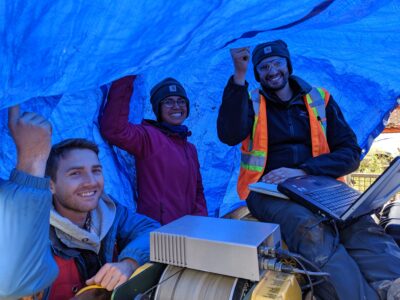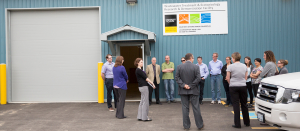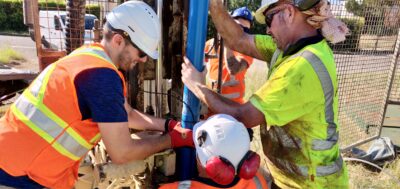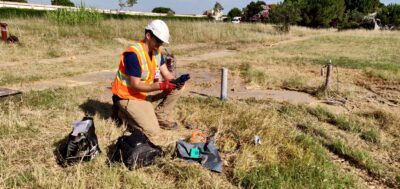The University of Guelph is aiming to become one of the top research-intensive universities in Canada. To get there, they’re taking a One Health approach: a strategy that recognizes the interdependency of human, animal and environmental health.
And a big part of that is water research.
University of Guelph is home to academic heavyweights like Beth Parker, an award-winning NSERC Chair in Groundwater Contamination in Fractured Media, and geological engineer John Cherry, whose work in groundwater contamination earned the 2020 Stockholm Water Prize.
But what really sets the University apart is the depth and breadth of water research — and the collegial atmosphere. Here, environmental engineers and geographers work alongside soil scientists to address agricultural runoff. Labs track COVID levels in the city’s wastewater. And investigators probe everything from water supply security to freshwater health.
Meanwhile, the institution has a long track record of working with industry partners to solve real-world problems.
“Facilitating those partnerships with the private sector is huge,” says Malcolm Campbell, the University’s Vice-President (Research).
Campbell points to the OWC-supported Guelph Wastewater Facility as a prime example. A partnership between the University and the City of Guelph, the demonstration site gives companies and researchers direct access to municipal wastewater streams to test new technologies. It also provides opportunities to early-career researchers like Cameron Farrow, who worked there during his post-doc.
Low-tech solutions to high-stakes water problems
Today Farrow is a professor in the University’s school of engineering, where he’s tackling the challenges of unsafe drinking water. “It’s just staggering,” he says. “Diarrheal disease kills more children per day than measles, mumps and AIDS combined.” Nor is it limited to so-called developing countries, he adds, pointing to the frequent boil water advisories in Indigenous communities across Canada.
Farrow’s ceramic water filters offer a compelling solution. They’re created by mixing clay with finely milled rice husks, sawdust or other burnable materials. Once the filter is fired in a kiln, those materials burn away, leaving a clay disk with tiny holes that allow water to pass through but trap bacterial contaminants.
“It’s about as low tech as you can get,” he says.
That simplicity is by design. Technologies like nanoengineered membranes and UV treatment systems provide excellent treatment. But to be practical in low-income, under-resourced communities, solutions have to be affordable, easy to operate and made using materials at hand.
Now, Farrow’s team is trying to figure out the best filter shape to avoid contamination of the active surface. They’re also working on how to inactivate tiny viruses, which can pass through the filter’s pores.
But the depth of water-related knowledge at the University of Guelph and the collaborative environment means help is always close by.
“[If] you run into a problem you’re not familiar with, often down the hall there’s someone who’s an expert,” says Farrow. “Instead of searching through the literature, you can just knock on the door and bring someone a muffin.”
Digging deep for answers
Those experts include people like Jonathan Munn, an assistant professor and principal investigator at the University’s Morwick G360 Groundwater Research Institute. Directed by Beth Parker, the institute focuses on the hidden world of aquifers, which provide drinking water to much of the world’s population and feed so much of the world’s surface water.
“Groundwater is invisible, but it’s a critical resource,” says Munn. “The vast majority of fresh water is in the ground beneath our feet.”
Today, groundwater faces unprecedented threats, from road salt and industrial spills to changing precipitation patterns that limit how much can be pumped out.
“Global aquifers have never been under more stress from contamination or over-extraction,” says Munn.
To assess what’s going on below the surface, he installs fibre optic cables inside boreholes drilled deep into the bedrock that allow detailed profiles of temperature to be measured. By heating the cable and measuring the rates of temperature change, his team can calculate which fractures within the aquifer have active flow, how much water is flowing, and even in what direction.
By combining those results with data from other groundwater research sites — including the Fractured Rock Observatory on the University of Guelph campus, partially funded by OWC — Munn aims to create a clearer picture of what aquifers look like, how they’re changing over time and how to use them responsibly.
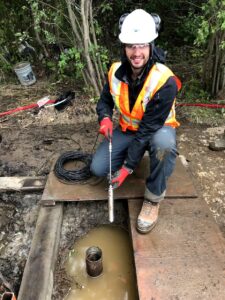
Dr. Jonathan Munn is installing a fiber optic cable in a recently drilled borehole in the Northwest Territories.
In recent years, Munn’s team has applied their high-tech approach in the Northwest Territories and multiple sites
around the world.
“It is a challenge to try and adapt it to these different environments,” he says. “But that’s the fun part … If it was easy, it wouldn’t be research.”
Helping new investigators make a splash
Talented investigators like Farrow and Munn are helping the University of Guelph achieve its goal of becoming an even bigger research powerhouse. OWC is playing an important role as well, says Campbell — and not only by providing important research infrastructure like boreholes and wastewater testing facilities.
He points to how the Ontario Water Consortium also provides mentoring and plays matchmaker, connecting the academic community with funders, municipalities and industrial partners. “I think they’re doing a fantastic job,” he says. “There’s huge value for an early-career researcher.”


